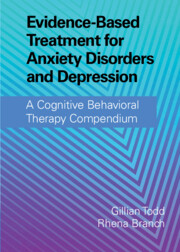 Evidence-Based Treatment for Anxiety Disorders and Depression
Evidence-Based Treatment for Anxiety Disorders and Depression Assessment, Treatment, and New Developments
from Part Three - Cognitive Behavioral Therapy for Obsessive-Compulsive Disorder and Associated Disorders
Published online by Cambridge University Press: 06 January 2022
Cognitive behavior therapy (CBT) is the treatment of choice for people with body dysmorphic disorder (BDD). The first part of the chapter describes the clinical features and processes of BDD, and introduces an updated CBT model of the self as an aesthetic object that evolves around the notion that people with BDD experience distressing mental imagery of their disliked features, maintained by self-focused attention and safety-seeking behaviors. In the second part of the chapter, we present an updated assessment and treatment protocol to BDD. We use case material to illustrate how to engage clients and socialize them into a psychological way of working to overcome their appearance concerns. We illustrate assessment and formulation, how to set up effective behavioral experiments, how to conduct mirror retraining, imagery rescripting, and compassion-focused techniques. BDD screening and diagnostic measures are also presented.
To save this book to your Kindle, first ensure [email protected] is added to your Approved Personal Document E-mail List under your Personal Document Settings on the Manage Your Content and Devices page of your Amazon account. Then enter the ‘name’ part of your Kindle email address below. Find out more about saving to your Kindle.
Note you can select to save to either the @free.kindle.com or @kindle.com variations. ‘@free.kindle.com’ emails are free but can only be saved to your device when it is connected to wi-fi. ‘@kindle.com’ emails can be delivered even when you are not connected to wi-fi, but note that service fees apply.
Find out more about the Kindle Personal Document Service.
To save content items to your account, please confirm that you agree to abide by our usage policies. If this is the first time you use this feature, you will be asked to authorise Cambridge Core to connect with your account. Find out more about saving content to Dropbox.
To save content items to your account, please confirm that you agree to abide by our usage policies. If this is the first time you use this feature, you will be asked to authorise Cambridge Core to connect with your account. Find out more about saving content to Google Drive.